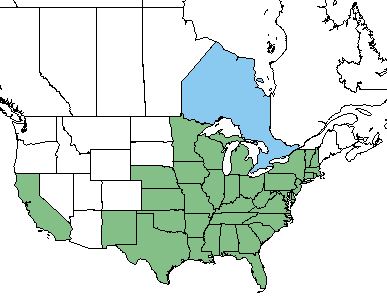Difference between revisions of "Tridens flavus"
(→Ecology) |
|||
| Line 34: | Line 34: | ||
''T. flavus'' proliferates in roadsides, disturbed areas, and glades. <ref name= "Weakley 2015"> Weakley, A. S. (2015). Flora of the Southern and Mid-Atlantic States. Chapel Hill, NC, University of North Carolina Herbarium. </ref> | ''T. flavus'' proliferates in roadsides, disturbed areas, and glades. <ref name= "Weakley 2015"> Weakley, A. S. (2015). Flora of the Southern and Mid-Atlantic States. Chapel Hill, NC, University of North Carolina Herbarium. </ref> | ||
| − | + | Specimens have been collected from drying loamy sands, burned pineland, bank of rivers, cypress swamp bank, open field, hammock, wooded floodplain, and pine-oak flatwood. <ref name = "FSU herbarium"> URL: http://herbarium.bio.fsu.edu. Last accessed: June 2018. Collectors: Loran C. Anderson, R.K. Godfrey, Julia Neel, Roy Komarek, Robert Norris, A.F. Clewell, R. Kral, J. P. Gillespie, D.L. Martin, S. T. Cooper, R.D. Houk, Richard Mitchell, Cecil Slaughter, Marc Minno, Ann F. Johnson, Wilson Baker, Billie Bailey, Alan Franck, Peter Simones, M. Darst, A. Gholson, Kathleen Craddock Burks, Gary Knight. States and counties: Florida (Wakulla, Leon, Hamilton, Marion, Liberty, Jackson, Dixie, Okaloosa, Nassau, St. Johns, Volusia, Calhoun, Lafayette, Walton) Georgia (Grady, THomas)</ref> | |
| + | |||
===Phenology=== <!--Timing off flowering, fruiting, seed dispersal, and environmental triggers. Cite PanFlora website if appropriate: http://www.gilnelson.com/PanFlora/ --> | ===Phenology=== <!--Timing off flowering, fruiting, seed dispersal, and environmental triggers. Cite PanFlora website if appropriate: http://www.gilnelson.com/PanFlora/ --> | ||
''T. flavus'' flowers in October. <ref name= "PanFlora"> PanFlora Author: Gil Nelson URL: [http://www.gilnelson.com/PanFlora/ http://www.gilnelson.com/PanFlora/] Date Accessed: 5/29/18 </ref> | ''T. flavus'' flowers in October. <ref name= "PanFlora"> PanFlora Author: Gil Nelson URL: [http://www.gilnelson.com/PanFlora/ http://www.gilnelson.com/PanFlora/] Date Accessed: 5/29/18 </ref> | ||
Revision as of 12:36, 22 June 2018
Common name: redtop [1], tall redtop [1], purpletop tridens [1], greasy grass [1], Chapman's tridens [2]
| Tridens flavus | |
|---|---|

| |
| Photo by John Gwaltney hosted at Southeastern Flora.com | |
| Scientific classification | |
| Kingdom: | Plantae |
| Division: | Magnoliophyta - Flowering plants |
| Class: | Liliopsida - Moncots |
| Order: | Poales |
| Family: | Poaceae |
| Genus: | Tridens |
| Species: | T. flavus |
| Binomial name | |
| Tridens flavus (L.) Hitchc. | |

| |
| Natural range of Tridens flavus from USDA NRCS Plants Database. | |
Contents
Taxonomic Notes
Synonyms: none
Varieties: none
Description
T. flavus is a perennial graminoid of the Poaceae family native to North America and introduced to Canada. [2]
Distribution
T. flavus is found in the eastern half of the United States as well as California, and in the Ontario region of Canada. [2]
Ecology
Habitat
T. flavus proliferates in roadsides, disturbed areas, and glades. [1]
Specimens have been collected from drying loamy sands, burned pineland, bank of rivers, cypress swamp bank, open field, hammock, wooded floodplain, and pine-oak flatwood. [3]
Phenology
T. flavus flowers in October. [4]
Fire ecology
T. flavus is not fire resistant, but has high fire tolerance. [2]
Use by animals
T. flavus has high palatability for grazing and browsing animals. [2]
Conservation and Management
Cultivation and restoration
Photo Gallery
References and notes
- ↑ 1.0 1.1 1.2 1.3 1.4 Weakley, A. S. (2015). Flora of the Southern and Mid-Atlantic States. Chapel Hill, NC, University of North Carolina Herbarium.
- ↑ 2.0 2.1 2.2 2.3 2.4 USDA Plant Database https://plants.usda.gov/core/profile?symbol=TRFL2
- ↑ URL: http://herbarium.bio.fsu.edu. Last accessed: June 2018. Collectors: Loran C. Anderson, R.K. Godfrey, Julia Neel, Roy Komarek, Robert Norris, A.F. Clewell, R. Kral, J. P. Gillespie, D.L. Martin, S. T. Cooper, R.D. Houk, Richard Mitchell, Cecil Slaughter, Marc Minno, Ann F. Johnson, Wilson Baker, Billie Bailey, Alan Franck, Peter Simones, M. Darst, A. Gholson, Kathleen Craddock Burks, Gary Knight. States and counties: Florida (Wakulla, Leon, Hamilton, Marion, Liberty, Jackson, Dixie, Okaloosa, Nassau, St. Johns, Volusia, Calhoun, Lafayette, Walton) Georgia (Grady, THomas)
- ↑ PanFlora Author: Gil Nelson URL: http://www.gilnelson.com/PanFlora/ Date Accessed: 5/29/18